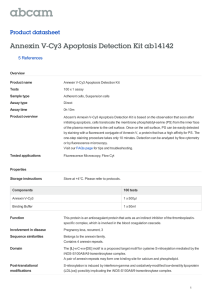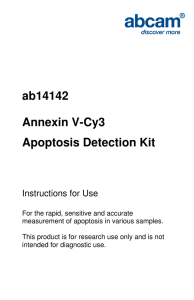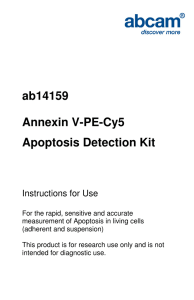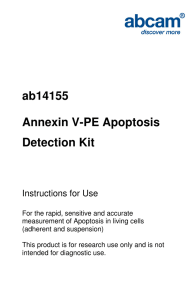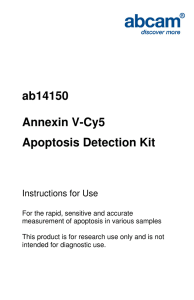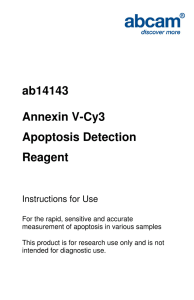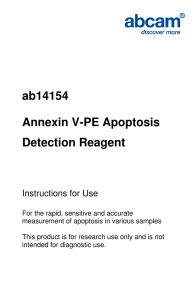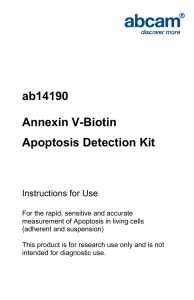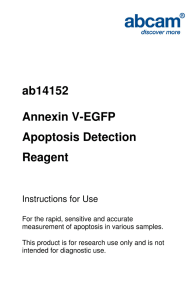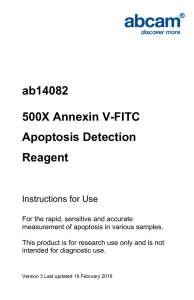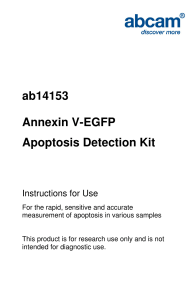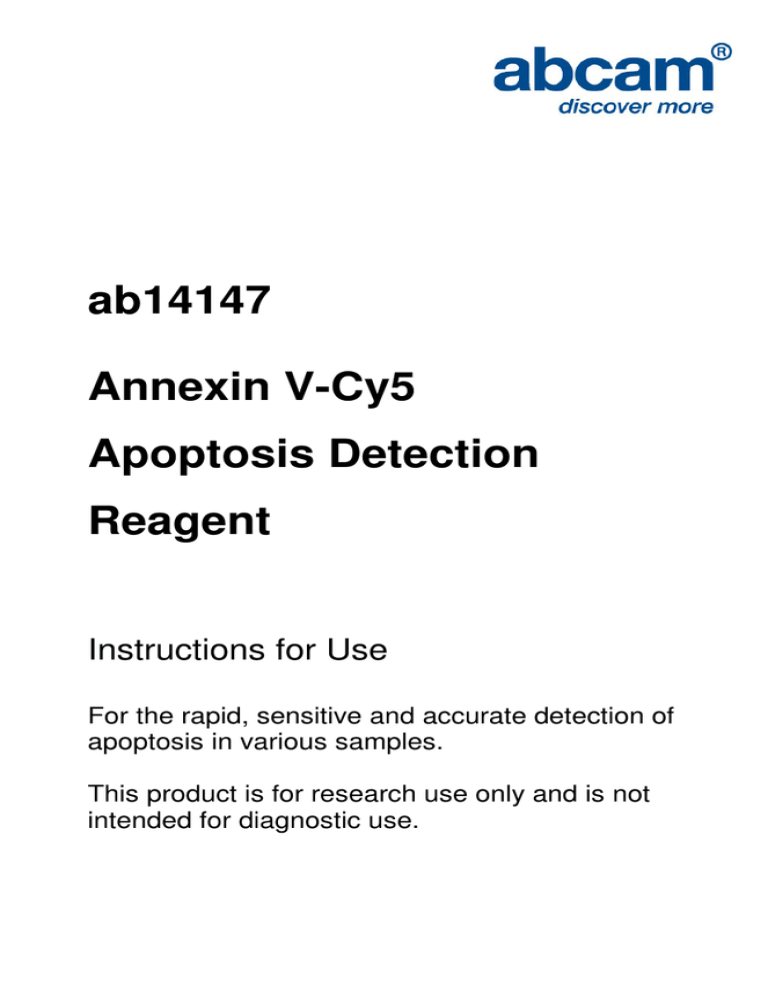
ab14147
Annexin V-Cy5
Apoptosis Detection
Reagent
Instructions for Use
For the rapid, sensitive and accurate detection of
apoptosis in various samples.
This product is for research use only and is not
intended for diagnostic use.
1
Table of Contents
1.
Overview
3
2.
Protocol Summary
3
3.
Components and Storage
4
4.
Assay Protocol
5
5.
Troubleshooting
7
2
1. Overview
Annexin V-Cy5 is a bright fluorescent reagent for detecting of the
early stages of apoptosis. During apoptosis, phosphatidylserine (PS)
is translocated from the cytoplasmic face of the plasma membrane to
the cell surface.
2+
Annexin V has a strong, Ca -dependent affinity for PS and therefore
serves as a probe for detecting apoptosis. Cy5 fluorescent dye
produces an intense signal in the far-red region of the spectrum and
therefore it is very useful for multiple labeling of cells with green and
red colored fluorescent probes. Cy5 yields fluorescence with a λmax
emission of 670 nm.
2. Protocol Summary
Induce Apoptosis in Sample Cells
Add Annexin V Binding Buffer (ab14084)
Add Annexin V-Cy5
Quantify Using Flow Cytometry
OR
Detect Using Fluorescence Microscopy
3
3. Components and Storage
A. Kit Components
Item
Quantity
Annexin V-Cy5 Apoptosis Detection
Reagent
1 vial
Store at +4°C. Do not freeze. Stable for one year under proper
storage conditions.
B. Additional Materials Required
•
1X Annexin V Binding Buffer (ab14084)
•
Microcentrifuge
•
Pipettes and pipette tips
•
Flow Cytometer or Fluorescence Microscope
•
Glass slides and coverslips
4
4. Assay Protocol
1. Incubation of cells with Annexin V-Cy5:
a) Induce apoptosis by desired methods.
5
b) Collect 1 x 10 cells by centrifugation.
c) Re-suspend cells in 500 µl of 1X Annexin V Binding Buffer
d) Add 1 µl of Annexin V-Cy5.
e) Incubate at room temperature for 5 min in the dark.
Proceed to Step 2 or 3 below depending on method of analysis.
2. Quantification by Flow Cytometry:
Analyze Annexin V-Cy5 binding by flow cytometry (Ex = 649 nm;
Em = 670 nm) using Helium-Neon Laser.
For analyzing adherent cells, gently trypsinize and wash cells once
with serum-containing media before incubation with Annexin V-Cy5
(Step 1.c-e).
5
3. Detection by Fluorescence Microscopy:
a) Place the cell suspension from Step 1.e on a glass slide. Cover
the cells with a glass coverslip.
For analyzing adherent cells, grow cells directly on a coverslip.
Following incubation (1.e), invert coverslip on glass slide and
visualize cells. The cells can also be washed and fixed in 2%
paraformaldehyde before visualization.
Note:
Cells must be incubated with Annexin V-Cy5 before fixation since
any cell membrane disruption can cause non-specific binding of
Annexin V to PS on the inner surface of the cell membrane.
b) Observe the cells under a fluorescence microscope using a Cy5
filter
or
a FITC/Cy3/Cy5 triple band filter
set
(Chroma
Technology) if you perform triple labeling with these dyes, or
detect cells using CCD camera.
Cells that have bound Annexin V-Cy5 will show bright red-blue
staining on the plasma membrane.
6
5. Troubleshooting
Problem
High
Background
Reason
Cell
Solution
density
higher
is
than
Refer to datasheet and use the
suggested cell number
recommended
Increased volumes
of components
added
Incubation of cell
samples for
extended periods
Use calibrated pipettes
accurately
Refer to datasheets and
incubate for exact times
Use of extremely
confluent cells
Perform assay when cells are at
80-95% confluency
Contaminated
cells
Check for bacteria/ yeast/
mycoplasma contamination
7
Problem
Lower signal
levels
Reason
Solution
Washing cells with
Always use binding buffer for
PBS
washing cells
before/after
fixation (adherent
cells)
Cells did not
initiate apoptosis
Determine the time-point for
initiation of apoptosis after
induction (time-course
experiment)
Very few cells
used for analysis
Refer to data sheet for
appropriate cell number
Incorrect setting of
the equipment
used to read
samples
Refer to datasheet and use the
recommended filter setting
Use of expired kit
or improperly
stored reagents
Always check the expiry date
and store the components
appropriately
8
Problem
Reason
Solution
Erratic results
Uneven number of
Seed only healthy cells (correct
cells seeded in the
passage number)
wells
Adherent cells
dislodged at the
time of experiment
Incorrect
incubation times or
temperatures
Perform experiment gently and
in duplicates or triplicates for
each treatment
Refer to datasheet & verify
correct incubation times and
temperatures
Incorrect volumes
used
Use calibrated pipettes and
aliquot correctly
Increased or
random staining
observed in
adherent cells
Always stain cells with Annexin
before fixation (makes cell
membrane leaky)
For further technical questions please do not hesitate to
contact us by email (technical@abcam.com) or phone (select
“contact us” on www.abcam.com for the phone number for
your region).
9
10
UK, EU and ROW
Email: technical@abcam.com
Tel: +44 (0)1223 696000
www.abcam.com
US, Canada and Latin America
Email: us.technical@abcam.com
Tel: 888-77-ABCAM (22226)
www.abcam.com
China and Asia Pacific
Email: hk.technical@abcam.com
Tel: 108008523689 (中國聯通)
www.abcam.cn
Japan
Email: technical@abcam.co.jp
Tel: +81-(0)3-6231-0940
www.abcam.co.jp
Copyright © 2012 Abcam, All Rights Reserved. The Abcam logo is a registered trademark.
11
All information / detail is correct at time of going to print.

